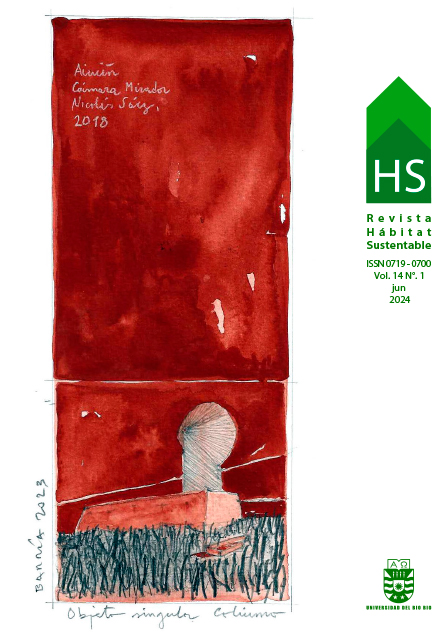Melhorando a eficiência energética em fachadas de vidro por meio de estratégias de design biomimético
DOI:
https://doi.org/10.22320/07190700.2024.14.01.03Palavras-chave:
biomimética, design de fachadas, eficiência energética, termorregulaçãoResumo
A indústria da construção, responsável por grande parte do consumo de energia, procura soluções para reduzir o consumo de energia. Este estudo propõe fachadas biomiméticas para garantir conforto térmico. Primeiramente, examinou sistemas de fachadas biomiméticos na literatura. Em seguida, analisou os métodos de termorregulação da natureza, o nível de biomimética e as estratégias desenvolvidas pelos seres vivos. Como resultado das análises, a informação biológica sobre os três fenômenos selecionados foi ampliada e determinada como transferir o método de biomimética que poderia ser para a envolvente do edifício. Simulações energéticas foram realizadas na fachada de vidro do Süleyman Pasha Bath para avaliar a eficiência energética do envelope. Verificou-se que os métodos inspirados na natureza contribuíram significativamente para o consumo de energia do edifício quando os resultados da simulação da fachada projetada.
Downloads
Referências
ALY, Z., IBRAHIM, A., & ABDELMOHSEN, S. (2021). Augmenting passive actuation of hygromorphic skins in desert climates: learning from thorny devil lizard skins. In 9th International Conference of the Arab Society for Computer Aided Architectural Design, American University in Cairo, Egypt.
Asknature (n.d.). https://asknature.org/strategy/leaves-protect-from-freezing/
BADARNAH, L., FARCHI, Y. N., & KNAACK, U. (2010). Solutions from nature for building envelope thermoregulation. Design & Nature V: Comparing Design in Nature with Science and Engineering, 5, 251. https://doi.org/10.2495/DN100221
Cactus Kingdom (n.d.). https://cactuskingdom.ca/product/fenestraria-aurantiaca-baby-toes-seed/
ÇAĞLAR, S. (2020). Voronoi Diyagramları Dünyayı Anlamamızı Nasıl Sağlar? https://www.matematiksel.org/voronoi-diyagramlari-dunyayi-anlamamizi-nasil-saglar/
ENGIN, N. (2012). Enerji Etkin Tasarımda Pasif İklimlendirme: Doğal Havalandırma. Tesisat Mühendisliği, 129, 62-70. https://www.mmo.org.tr/sites/default/files/c8aa7c541085a2b_ek.pdf
FARAGALLA, A. M., & ASADI, S. (2022). Biomimetic design for adaptive building façades: a paradigm shift towards environmentally conscious architecture. Energies, 15(15), 5390. https://doi.org/10.3390/en15155390
FARCHI NACHMAN, Y. (2009). Learning from nature: Thermoregulation envelope, in Department of Building Technology. Delft University of Technology: Façade Design.
HELMS, M., VATTAM, S. S., & GOEL, A. K. (2009). Biologically inspired design: process and products. Design Studies, 30(5), 606–622. https://doi.org/10.1016/j.destud.2009.04.003
International Energy Agency. Energy Efficiency (2019). Buildings, The global exchange for energy efficiency policies, data and analysis.
KAHRAMANOĞLU, B., & ALP, N. Ç. (2021). Kinetik Sistemli Bina Cephelerinin Modelleme Yöntemlerinin İncelenmesi. AURUM Journal of Engineering Systems and Architecture, 5(1), 119-138. https://doi.org/10.53600/ajesa.861479
KALATHA, A. (2016). The water wall: A bio-inspired thermoregulative facade system. [Unpublished master thesis], Delft University of Technology, Netherlands.
KIM, K., & TORRES, A. (2021). Integrated Façades for Building Energy Conservation; IC-AIRES, Lecture Notes in Networks and Systems; Springer: Cham, Switzerland; 361.
KURU, A., OLDFIELD, P., BONSER, S., & FIORITO, F. (2019). Biomimetic adaptive building skins: Energy and environmental regulation in buildings. Energy and Buildings, 205, 109544. https://doi.org/10.1016/j.enbuild.2019.109544
LEE, E. S., & TAVIL, A. (2007). Energy and visual comfort performance of electrochromic windows with overhangs. Building and Environment, 42(6), 2439-2449. https://doi.org/10.1016/j.buildenv.2006.04.016
MUTLU AVINÇ, G., & ARSLAN SELÇUK, S. (2019). Mimari Tasarımda Biyomimetik Yaklaşımlar: Pavyonlar Üzerine Bir Araştırma. Online Journal Of Art & Design, 7(2), 92-107. http://www.adjournal.net/articles/72/728.pdf
ÖZTÜRK, BÜŞRA., (2023). Çağdaş eklerin tarihi yapının enerji performansına etkisinin incelenmesi [MSc thesis]. Konya Teknik University, Institute of Graduate Education, Konya.
PACHECO, R., ORDÓÑEZ, J., & MARTÍNEZ, G. (2012). Energy efficient design of building: A review. Renewable and Sustainable Energy Reviews, 16(6), 3559-3573. https://doi.org/10.1016/j.rser.2012.03.045
SHEIKH, W. T., & ASGHAR, Q. (2019). Adaptive biomimetic facades: Enhancing energy efficiency of highly glazed buildings. Frontiers of Architectural Research, 8(3), 319-331. https://doi.org/10.1016/j.foar.2019.06.001
SOMMESE, F., BADARNAH, L., & AUSIELLO, G. (2022). A critical review of biomimetic building envelopes: Towards a bio-adaptive model from nature to architecture. Renewable and Sustainable Energy Reviews, 169, 112850. https://doi.org/10.1016/j.rser.2022.112850
TABADKANI, A., ROETZEL, A., LI, H. X. & TSANGRASSOULIS, A. (2021). Design approaches and typologies of adaptive façades: A review. Automation in Construction. 121, 103450. https://doi.org/10.1016/j.autcon.2020.103450
PAAR, M. J., & PETUTSCHNIGG, A. (2016). Biomimetic inspired, natural ventilated facade–A conceptual study. Journal of Facade Design and Engineering, 4(3-4), 131-142. https://doi.org/10.3233/FDE-171645
ZARI, M. P. (2007). Biomimetic approaches to architectural design for increased sustainability. In The SB07 New Zealand Sustainable Building Conference, 33-42. https://www.semanticscholar.org/paper/BIOMIMETIC-APPROACHES-TO-ARCHITECTURAL-DESIGN-FOR-Zari/1a7b024096491c64beafc4d9b243f84a321cd697
Downloads
Publicado
Como Citar
Edição
Secção
Licença
Direitos de Autor (c) 2024 Büşra Öztürk, Güneş Mutlu-Avinç, Semra Arslan-Selçuk

Este trabalho encontra-se publicado com a Licença Internacional Creative Commons Atribuição-CompartilhaIgual 4.0.
O conteúdo dos artigos publicados em cada número do Habitat Sustentável é da exclusiva responsabilidade dos autores e não representa necessariamente o pensamento ou compromete a opinião da Universidad del Bío-Bío.
Os autores mantêm os seus direitos de autor e concedem à revista o direito de primeira publicação da sua obra, que está simultaneamente sujeita à Licença de Atribuição Creative Commons CC BY-SA que permite a outros partilhar, transformar ou criar novo material a partir desta obra para fins não comerciais, desde que a autoria e a primeira publicação nesta revista sejam reconhecidas, e as suas novas criações sejam licenciadas sob os mesmos termos.











 Programa de Informação Científica/Concurso Fondos de Publicación de Revistas Científicas 2018/ Proyecto Mejoramiento de Visibilidad de Revistas UBB (Código:FP180007)
Programa de Informação Científica/Concurso Fondos de Publicación de Revistas Científicas 2018/ Proyecto Mejoramiento de Visibilidad de Revistas UBB (Código:FP180007)





